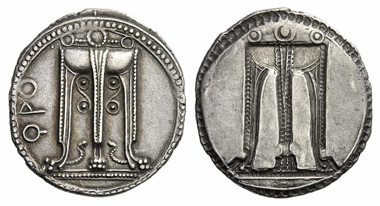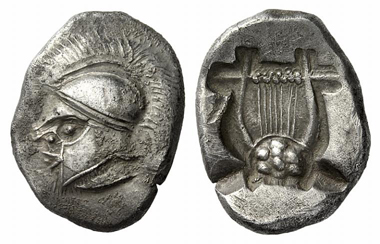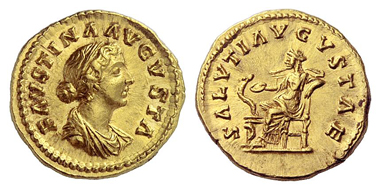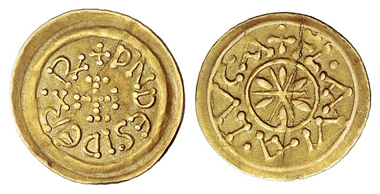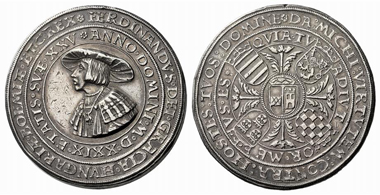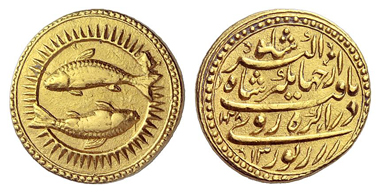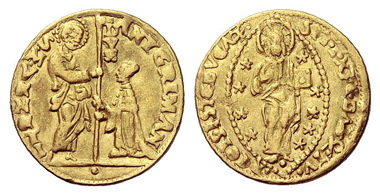08-12-2013 – 01-01-1970
Auction sale 157: Numismatic Rarities – Dr. Ferrari Collection, Dr. Sattler Collection
Top prices for numismatic rarities at Numismatik Lanz
It’s a tradition at Numismatik Lanz to call out the lots to be sold at just 60 % of the pre-sale estimate. You would think that this leads to rather modest results. Quite the contrary: attractive coins in an outstanding quality always obtain top prices, no matter the starting price.
48: Croton (Bruttium). Stater, 550-530. Rare. Extremely fine. Starting price: 1,800 euros. Hammer price: 9,000 euros.
A case in point is the cover piece, an incuse stater from Croton with a gorgeous tripod that obtained 9,000 euros on a starting price of 1,800 euros. It was a little bit more expensive than the extremely fine stater from Poseidonia, minted at roughly the same time, with a slight edge damage that fetched 7,000 euros.
More than 17 times the starting price was realized by a small, inconspicuous but extraordinarily preserved litra from Syracuse. It began with an estimate of 250 euros and a starting price of 150 euros, only to arrive at a hammer price of 2,600 euros in the end. Not quite that great but significantly was the rise of price of a Sicilian bronze coin of Timoleon. The extremely fine specimen was called out for 2,700 euros. Its proud new owner willingly paid 6,250 euros for it.
97: Thraco-Macedonian tribes. Uncertain mint. Double siglos, c. 500 B. C. Extremely rare. Extremely fine. Starting price: 24,000 euros. Hammer price: 65,000 euros.
The most expensive coin of the entire sale was a Thraco-Macedonian stater whose hitherto assumed production site was the island of Calymna. Recently, however, this Archaic work of art is associated with the coinage of tribes located in northern Greece instead. The extremely rare double siglos was called out for 24,000 euros. The hammer price was as high as 65,000 euros.
137: Cyzicus. El-stater, 460-400. Rare. Very fine. Starting price: 15,000 euros. Hammer price: 38,000 euros.
A gorgeous electrum stater from Cyzicus with the rare depiction of the founder of the city on horseback fetched 38,000 euros after being estimated at 15,000 euros. An impressive bronze medallion of the very city with an illustration of Kore on the obverse and the rape of Persephone on the reverse obtained 7,000 euros on a pre-sale estimate of 1,500 euros. Likewise impressive was the price obtained by a rather simple hekte from Mytilene whose obverse exhibits an unusually well preserved depiction of Gorgon that changed hands for 6,500 euros.
328: Faustina II, + 176. Aureus, 161-164. Mint state. E. Beckenbauer Coll. Bankhaus Aufhäuser 5 (1988), 317. Starting price: 9,000 euros. Hammer price: 23,000 euros.
Anyone looking for bargains these days should check out Roman coins, albeit not aurei because they attract as much interest as perfectly preserved Greek coins. A telling example was an aureus of Faustina II from the E. Beckenbauer Collection with an enchanting portrait of the empress. The piece had been estimated at 9,000 euros but was sold in the end for 23,000 euros.
An antoninianus of Regalianus, a magnificently preserved specimen of that emission, was available for a comparatively modest sum, i.e. 8,000 euros, and that corresponded exactly to the estimate.
Incredibly inexpensive, given its estimate, was an antoninianus of Proculus. It was called out for 30,000 euros and sold for 40,000 euros – not quite the price obtained by a slightly better preserved first specimen that was auctioned off by Bankhaus Aufhäuser in 1991.
434: Lombards. Desiderius, 757-773. Tremissis, Lucca. From auction sale Ratto 1965, no. 543. Extremely rare. About extremely fine. Starting price: 5,400 euros. Hammer price: 9,500 euros.
Truly outstanding was the large offer of coins from the Migration Period Numismatik Lanz was able to present. The high hammer prices bear witness to the great collectors’ interest. An inconspicuous, very finely preserved half-siliqua of Ostrogothic king Theia was called out for 1,800 euros but yielded 5,250 euros as a result. Even greater was the rise in price of an extremely fine tremissis of Cunincpert, king of the Lombards (688-700), which formerly was part of the Garret Collection. It obtained 5,750 euros on a starting price of 1,500 euros. The highest hammer price was achieved by an almost extremely fine tremissis of Desiderius, last king of the Lombard kingdom: 9,500 euros (starting price: 5.400 euros).
446: HRE. Ferdinand I, 1521-1564. 2 1/4 schauthaler 1529, Joachimstal. Trace of mounting(?), extremely fine. Starting price: 1,800 euros. Hammer price: 15,000 euros.
Numismatik Lanz offered the aficionados of medieval and modern numismatics a rich selection as well. By tradition, the focus was on the Holy Roman Empire. A 2 1/4 schauthaler from Joachimstal dating to 1529 sprang a surprise. The extremely fine item with the bust of Ferdinand I, small in size but monumental in appearance, was called out for modest 1,800 euros only to be finally sold for 15,000 euros.
A 10 ducat piece of Ferdinand III, minted in Prague in 1643, yielded 36,000 euros on a starting price of 24,000 euros, a broad 5 ducat piece of the Malcontents from 1703 realized 9,000 euros (starting price: 3,000 euros).
681: Islam. Mughal Empire. Nur-ad-Din Muhammad Jahangir, 1605-1628. Zodiac mohur, 1618. Rosen Coll. and Numismatik Lanz 41 (1987), 1162. Very rare. About extremely fine / extremely fine. Starting price: 4,500 euros. Hammer price: 42,000 euros.
The auction sale’s highflyer was a zodiac mohur of Mughal emperor Jahangir with a depiction of two fishes surrounded by solar rays. The very rare piece was sold for as high a price as 42,000 euros! The estimate had been 7,500 euros only.
759: Italy. Kingdom of Naples. Charles I of Anjou. Reale d’oro, Barletta. Grigoli 4 (1990), 569. Extremely rare. Extremely fine. Starting price: 15,000 euros. Hammer price: 42,000 euros.
Exactly the same result was achieved by an extremely rare reale d’oro of Charles I of Anjou from Barletta. His predecessor Frederick II, in contrast, obtained ‘only’ 25,000 euros with his extremely fine augustalis, on a starting price of 9,000 euros.
829: Italy. Venice. Antonio Grimani, 1521-1523. Ducato, n. y. Extremely rare. Very fine. Starting price: 12,000 euros. Hammer price: 21,000 euros.
Let us conclude this little review of the most recent auction sale of Numismatik Lanz with an extremely rare ducat of Venetian Doge Antonio Grimani (1521-1523). On a pre-sale estimate of 12,000 euros, the very fine piece yielded 21,000 euros.
You may find all results on the internet.
The next auction sale is scheduled for June 2014. Consignments are accepted at any time. Further information is available at Numismatik Lanz, Maximiliansplatz 10, D-80333 Munich, email, phone: +49 / 89 / 29 90 70, fax: +49 / 89 / 22 07 62.




